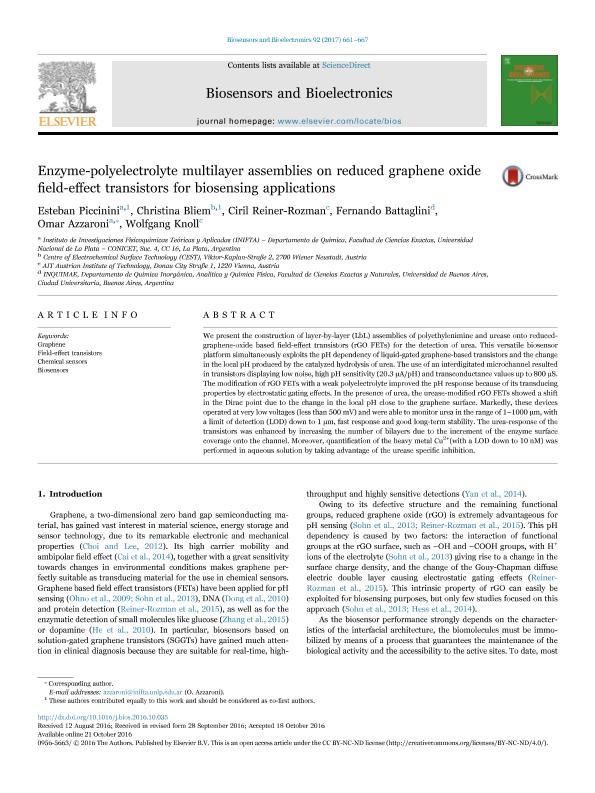Artículo
Enzyme-polyelectrolyte multilayer assemblies on reduced graphene oxide field-effect transistors for biosensing applications
Piccinini, Esteban ; Bliem, Christina; Reiner Rozman, Ciril; Battaglini, Fernando
; Bliem, Christina; Reiner Rozman, Ciril; Battaglini, Fernando ; Azzaroni, Omar
; Azzaroni, Omar ; Knoll, Wolfgang
; Knoll, Wolfgang
 ; Bliem, Christina; Reiner Rozman, Ciril; Battaglini, Fernando
; Bliem, Christina; Reiner Rozman, Ciril; Battaglini, Fernando ; Azzaroni, Omar
; Azzaroni, Omar ; Knoll, Wolfgang
; Knoll, Wolfgang
Fecha de publicación:
06/2017
Editorial:
Elsevier Advanced Technology
Revista:
Biosensors & Bioelectronics
ISSN:
0956-5663
Idioma:
Inglés
Tipo de recurso:
Artículo publicado
Clasificación temática:
Resumen
We present the construction of layer-by-layer (LbL) assemblies of polyethylenimine and urease onto reduced-graphene-oxide based field-effect transistors (rGO FETs) for the detection of urea. This versatile biosensor platform simultaneously exploits the pH dependency of liquid-gated graphene-based transistors and the change in the local pH produced by the catalyzed hydrolysis of urea. The use of an interdigitated microchannel resulted in transistors displaying low noise, high pH sensitivity (20.3 µA/pH) and transconductance values up to 800 µS. The modification of rGO FETs with a weak polyelectrolyte improved the pH response because of its transducing properties by electrostatic gating effects. In the presence of urea, the urease-modified rGO FETs showed a shift in the Dirac point due to the change in the local pH close to the graphene surface. Markedly, these devices operated at very low voltages (less than 500 mV) and were able to monitor urea in the range of 1–1000 µm, with a limit of detection (LOD) down to 1 µm, fast response and good long-term stability. The urea-response of the transistors was enhanced by increasing the number of bilayers due to the increment of the enzyme surface coverage onto the channel. Moreover, quantification of the heavy metal Cu2+(with a LOD down to 10 nM) was performed in aqueous solution by taking advantage of the urease specific inhibition.
Palabras clave:
Biosensors
,
Chemical Sensors
,
Field-Effect Transistors
,
Graphene
Archivos asociados
Licencia
Identificadores
Colecciones
Articulos(INIFTA)
Articulos de INST.DE INV.FISICOQUIMICAS TEORICAS Y APLIC.
Articulos de INST.DE INV.FISICOQUIMICAS TEORICAS Y APLIC.
Citación
Piccinini, Esteban; Bliem, Christina; Reiner Rozman, Ciril; Battaglini, Fernando; Azzaroni, Omar; et al.; Enzyme-polyelectrolyte multilayer assemblies on reduced graphene oxide field-effect transistors for biosensing applications; Elsevier Advanced Technology; Biosensors & Bioelectronics; 92; 6-2017; 661-667
Compartir
Altmétricas



